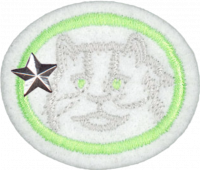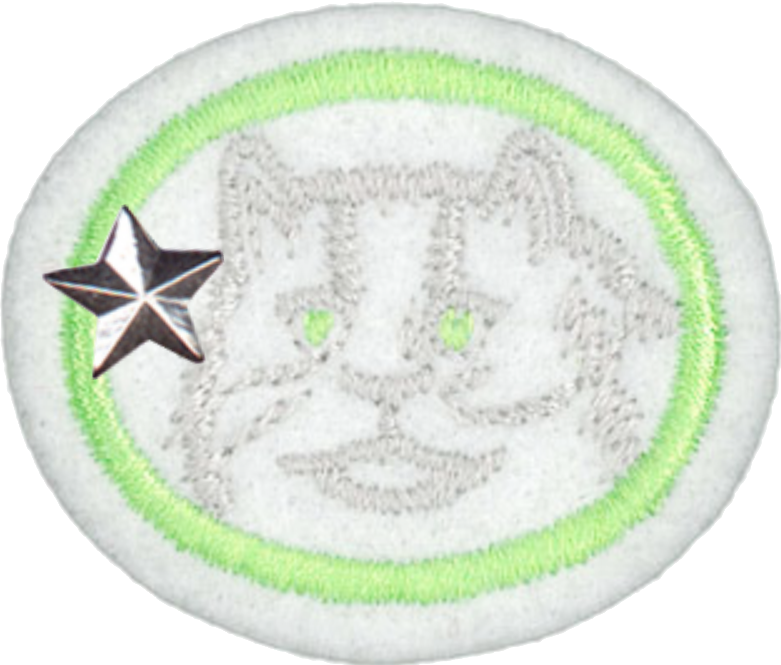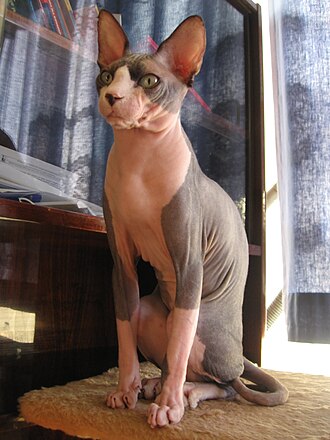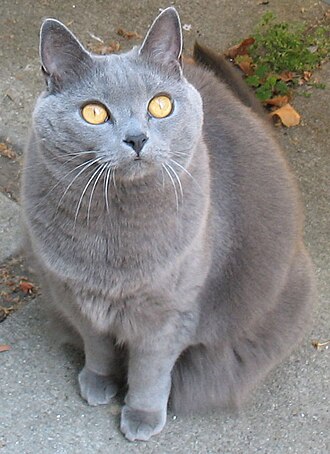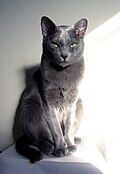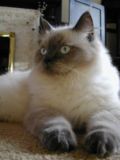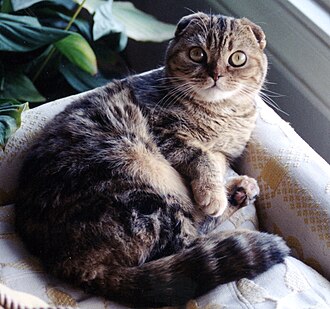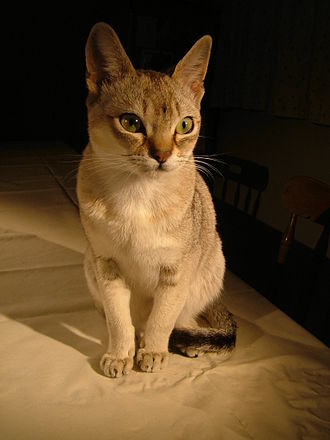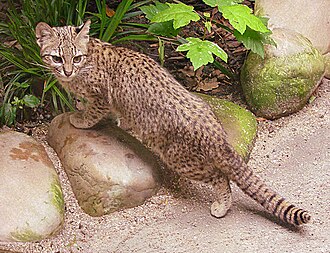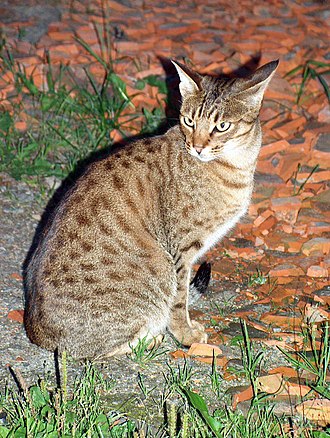Difference between revisions of "AY Honors/Cats - Advanced/Answer Key"
m (- Category of AYHAB) |
|||
| (758 intermediate revisions by more than 100 users not shown) | |||
| Line 1: | Line 1: | ||
| − | + | {{HonorSubpage}} | |
| + | <section begin="Body" /> | ||
| + | {{ansreq|page={{#titleparts:{{PAGENAME}}|2|1}}|num=1}} | ||
| + | <noinclude><translate><!--T:67--> | ||
| + | </noinclude> | ||
| + | <!-- 1. Have the basic Cat honor. --> | ||
| + | {{honor_prerequisite|honor=Cats}} | ||
| − | + | <!--T:68--> | |
| + | <noinclude></translate></noinclude> | ||
| + | {{CloseReq}} <!-- 1 --> | ||
| + | {{ansreq|page={{#titleparts:{{PAGENAME}}|2|1}}|num=2}} | ||
| + | <noinclude><translate><!--T:69--> | ||
| + | </noinclude> | ||
| + | <!-- 2. Know about cats "open-book" quiz. (This is not an instructional pass-a-test requirement, it is designed to encourage research into the world of cats.) Enjoy new discoveries as you research the following questions about some unusual domestic cat breeds from around the world. --> | ||
| + | <noinclude></translate></noinclude> | ||
| + | {{ansreq|page={{#titleparts:{{PAGENAME}}|2|1}}|num=2a}} | ||
| + | <noinclude><translate><!--T:70--> | ||
| + | </noinclude> | ||
| + | [[Image:Sphinx2_July_2006.jpg|thumb|Sphynx]] | ||
| + | The Sphynx (aka Canadian Hairless) is a rare breed of cat with extremely little fur, or at most a short fuzz over its body, and no, or very short and stiff whiskers. Their skin is the color their fur would be, and all the usual cat marking patterns (solid, point, van, tabby, tortie, etc.) may be found in Sphynx too. They are sometimes mistaken for Chihuahuas because of their extremely unusual and, some say, uncatlike appearance. They are extremely intelligent, extroverted, and affectionate, often cuddling with their owners, other humans, and each other. | ||
| + | <br style="clear:both"> | ||
| − | + | <!--T:71--> | |
| + | <noinclude></translate></noinclude> | ||
| + | {{CloseReq}} <!-- 2a --> | ||
| + | {{ansreq|page={{#titleparts:{{PAGENAME}}|2|1}}|num=2b}} <!--T:3--> | ||
| + | <noinclude><translate><!--T:72--> | ||
| + | </noinclude> | ||
| + | [[Image:Chartreux cat J adult female 001.jpg|thumb|Chartruex cat]] | ||
| + | True. | ||
| − | + | <!--T:4--> | |
| − | + | The Chartreux is an internationally recognized breed of domestic cat from France. There is a legend that the Chartreux are descended from cats brought to France by Carthusian monks to live in the order's head monastery, the Grande Chartreuse, located in the Chartreuse Mountains north of the city of Grenoble (Siegal 1997:27). But in 1972, the Prior of the Grande Chartreuse denied that the monastery's archives held any records of the monks' use of any breed of cat resembling the Chartreux (Simonnet 1990:36–37). Legend also has it that the Chartreux's ancestors were feral mountain cats from what is now Syria, brought back to France by returning Crusaders in the 13th century, many of whom entered the Carthusian monastic order. The first documented mention of the breed was by the French naturalist Buffon in the 17th century. The breed was largely decimated during the first World War and wild populations were not seen after World War Two. A concerted effort by European breeders kept the breed from extinction. The first Chartreux were brought to the USA in 1971 by Helen and John Gammon of La Jolla, California. There are fewer than two dozen active Chartreux breeders in North America as of 2007. | |
| + | <br style="clear:both"> | ||
| − | + | <!--T:73--> | |
| + | <noinclude></translate></noinclude> | ||
| + | {{CloseReq}} <!-- 2b --> | ||
| + | {{ansreq|page={{#titleparts:{{PAGENAME}}|2|1}}|num=2c}} <!--T:5--> | ||
| + | <noinclude><translate></noinclude> | ||
| + | <gallery> | ||
| + | Image:Veda,chat-adulte-mâle-race-korat.JPG|'''1-c''' Korat, whose name in Thai means "Good Fortune" | ||
| + | Image:Ragdoll Blue Colourpoint.jpg|'''2-a''' Ragdoll cat, so name because it goes limp when picked up | ||
| + | Image:Sokoke_dalili.jpg|'''3-b''' Sokoke cats originated in Kenya | ||
| + | </gallery> | ||
| + | ====Korat==== <!--T:74--> | ||
| + | The Korat is one of the oldest stable breeds of cat. Originating in Thailand, it is named after the Nakhon Ratchasima province, although in Thailand it is often known as Si-Sawat, which means '''good fortune'''. In fact they are often known colloquially as the "Good Luck Cat" and are given in pairs to newlyweds or people of high esteem as a wish for good luck. | ||
| − | + | <!--T:6--> | |
| + | The first known written mention of the Korat was in "The Cat-Book Poems" authored between 1350 and 1767 AD in Thailand, now preserved in the National library in Bangkok. They first appeared in America in the 1950s and arrived in Britain from there in 1972. | ||
| − | + | <!--T:7--> | |
| + | Korats are a shorthair with a small to medium build and a low percentage of body fat; their bodies are often described as semi-cobby, and are surprisingly heavy for their size. They are an active cat and form strong bonds with people. | ||
| − | + | Korats have several characteristics that together distinguish them as a breed: | |
| + | * Korats are one of a few breeds that have only one colour. | ||
| + | * Jean Johnson first introduced Korats to the US in 1959. She had lived in Thailand, where she first encountered the breed. Her first pair were named Nara (male) and Dara (female). | ||
| + | ====Ragdoll==== <!--T:8--> | ||
| + | The Ragdoll is a breed of medium longhaired cat. It is best known for its docile and placid temperament and affectionate nature. They are non-aggressive to the point that many cats cannot or should not be let outside for prolonged periods as many will not defend themselves and most do not hunt. The name "Ragdoll" derived from the fact that many of these cats go completely limp and relax when picked up. Ragdolls have a sturdy body, short legs, and a thick coat with Siamese-style points. | ||
| + | ====Sokoke==== | ||
| + | The original name of the breed was Khadzonzos. The Khadzonzos cats were discovered in the Arabuko-Sokoke forest, on the Kenyan coast, by Jeni Slater in 1978. Gloria Moeldrop, a friend of Slater's, brought some of the cats home with her to Denmark to breed. In 1990, she imported more cats from Kenya to strengthen the breeding stock. The cats were first shown in Copenhagen in 1984. The breed was officially recognized by the FIFe in 1993, with the name changed to Sokoke, after the place from whence they came. | ||
| − | + | <!--T:9--> | |
| + | Sokokes have blotched tabby coats in shades of brown, with amber to light green eyes. Their coats are short and coarse, with little to no undercoat. Their bodies are long and thin, with long legs. The back legs should be longer than the front legs, similar to an ocelot. Sokokes are very active and enjoy climbing and "talking" to their people. | ||
| − | + | <!--T:75--> | |
| + | <noinclude></translate></noinclude> | ||
| + | {{CloseReq}} <!-- 2c --> | ||
| + | {{ansreq|page={{#titleparts:{{PAGENAME}}|2|1}}|num=2d}} <!--T:10--> | ||
| + | <noinclude><translate><!--T:76--> | ||
| + | </noinclude> | ||
| + | [[Image:Scottish Fold.jpg|thumb|Scottish Fold]] | ||
| + | False. | ||
| − | + | <!--T:11--> | |
| + | The Scottish Fold is a breed of cat with a natural mutation to its ears. The ear cartilage contains a fold so the ears bend forward and down towards the front of their head. | ||
| − | + | <!--T:12--> | |
| + | The original Scottish Fold was a long-haired white-haired barn cat named Susie, who was found at a farm near Coupar Angus in Perthshire, Scotland in 1961. Susie's ears had an unusual fold in their middle, making her resemble an owl. When Susie had kittens, two of them were born with folded ears, and one of the siblings was acquired by William Ross, a neighboring farmer and cat-fancier. Ross registered the breed with the Governing Council of the Cat Fancy in Great Britain and started to breed Scottish Fold kittens with the help of geneticist Pat Turner. The breeding program produced 76 kittens in the first three years - 42 with folded ears and 34 with straight ears. The conclusion from this was that the ear mutation is due to a simple dominant gene. If one parent provides the gene for straight ears, and one parent provides the gene for folded ears, the kittens will be Folds. | ||
| − | + | <!--T:13--> | |
| − | + | The breed was not accepted for showing in Great Britain and Europe as it was felt that they would be extremely prone to ear problems such as infection, mites and deafness, but the folds were exported to America and the breed continued to be established there using crosses with British Shorthair and the American Shorthair. | |
| − | + | <!--T:14--> | |
| + | Scottish Folds can be either long or short-haired, and they may have any coat color combination except for Siamese-style points. Pointed Folds have been bred but they are not eligible for showing. The original cats only had one fold in their ears, but due to selective breeding they have increased the fold to a double or triple crease that causes the ear to lie totally flat against the head. Scottish Folds, whether with folded ears or with normal ears, are typically good-natured and placid, and are known for sleeping on their backs. They tend to become very attached to their human caregivers and are by nature quite affectionate. Scottish Folds typically have soft voices and display a complex repertoire of meows and purrs not found in better-known breeds. | ||
| − | + | <!--T:15--> | |
| + | There is one medical problem that has been found to be related to Scottish Fold breeding. If both parents have folded ears, their kittens will be extremely prone to developing a painful degenerative joint disease that fuses the tail, ankles and knees. This condition also affects Scottish folds with one copy of the fold gene, to a lesser degree, and is the reason the breed is not accepted by the Governing Council of the Cat Fancy and the Fédération Internationale Féline. | ||
| − | + | <!--T:77--> | |
| + | <noinclude></translate></noinclude> | ||
| + | {{CloseReq}} <!-- 2d --> | ||
| + | {{ansreq|page={{#titleparts:{{PAGENAME}}|2|1}}|num=2e}} <!--T:16--> | ||
| + | <noinclude><translate><!--T:78--> | ||
| + | </noinclude> | ||
| + | [[Image:Raffles_singapura_cat.jpg|thumb|Singapura, also known as the Drain Cat]] | ||
| + | The Singapura is also known as the '''Drain Cat'''. | ||
| + | <br style="clear:both"> | ||
| − | == | + | <!--T:79--> |
| + | <noinclude></translate></noinclude> | ||
| + | {{CloseReq}} <!-- 2e --> | ||
| + | {{ansreq|page={{#titleparts:{{PAGENAME}}|2|1}}|num=2f}} <!--T:17--> | ||
| + | <noinclude><translate><!--T:80--> | ||
| + | </noinclude> | ||
| + | True. | ||
| − | + | <!--T:18--> | |
| + | The Poodle Cat was developed in Starnberg, Germany by a Scottish Fold breeder named Rosemarie Wolf. It is a cross between a Scottish Fold and a Devon Rex. | ||
| − | == | + | <!--T:81--> |
| − | + | <noinclude></translate></noinclude> | |
| + | {{CloseReq}} <!-- 2f --> | ||
| + | {{ansreq|page={{#titleparts:{{PAGENAME}}|2|1}}|num=2g}} <!--T:19--> | ||
| + | <noinclude><translate><!--T:82--> | ||
| + | </noinclude> | ||
| − | + | ====Geoffroy's cat==== <!--T:20--> | |
| + | [[Image:Salzkatze.jpg|thumb|Geoffroy's cat]] | ||
| + | Geoffroy's cat is not a breed of domestic cat developed in the UK. In fact, it is not a domestic cat at all! Geoffroy's Cat (Leopardus geoffroyi) is probably the most common wild cat in South America. It is about the size of a domestic cat. Its fur has black spots, but the background color varies from region to region; in the north, a brownish yellow coat is most common. Farther south, its coat are grayish. | ||
| − | + | <!--T:21--> | |
| + | Geoffroy's Cat primarily preys on rodents, small lizards, insects, and occasionally frogs and fish; it is at the top of the food chain. Although it appears to be plentiful, some conservationists are concerned because Geoffroy's Cat is hunted extensively for its pelt. | ||
| − | + | <!--T:22--> | |
| + | Geoffroy's Cat weighs only about 4-8 pounds and has a long tail and long legs. There have been attempts to breed this cat with domestic cats, but with very little success. Pregnant females appear to take extra care in choosing where they give birth to their kittens. Geoffroy's Cat kittens develop very quickly and at about 6 weeks they are fully mobile. | ||
| − | + | <!--T:23--> | |
| + | The species inhabits the Andes, Pampas (scrubby forest parts), and Gran Chaco landscape. | ||
| − | == | + | ====Abyssinian ==== <!--T:24--> |
| − | + | The Abyssinian is a natural breed of domesticated cat believed to originate from one Egyptian female kitten called Zula that was taken from a port in Alexandria, Egypt, by a British soldier and brought to England. | |
| − | |||
| − | == | + | ====Havana Brown==== <!--T:25--> |
| − | + | The Havana Brown, also known as the Swiss Mountain cat, is a breed of cat well known and shown in England in the 1890s. Similar to the oriental shorthair, full color cats, also known as non-blue eyed siamese, were known to interbreed with the pointed cats of siam. | |
| − | |||
| − | |||
| − | |||
| − | |||
| − | |||
| − | |||
| − | == | + | <!--T:26--> |
| − | + | During World War I and World War II, the breeding programs of pedigreed cats suffered. It was not until the post World War II era that time cat fanciers renewed their breeding efforts. In the early 1950s a group of English cat fanciers began working together to restore the breed. | |
| − | [[ | + | |
| + | <!--T:83--> | ||
| + | <noinclude></translate></noinclude> | ||
| + | {{CloseReq}} <!-- 2g --> | ||
| + | {{ansreq|page={{#titleparts:{{PAGENAME}}|2|1}}|num=2h}} <!--T:27--> | ||
| + | <noinclude><translate><!--T:84--> | ||
| + | </noinclude> | ||
| + | [[Image:Ocicat-sitting.jpg|thumb|Ocicat, legal everywhere]] | ||
| + | |||
| + | <!--T:28--> | ||
| + | False. | ||
| + | |||
| + | <!--T:29--> | ||
| + | The Ocicat is a new and still-rare breed of cat which has spots resembling a 'wild' cat and the temperament of a domestic animal, named for its resemblance to the ocelot. | ||
| + | |||
| + | <!--T:30--> | ||
| + | Despite its appearance, there is no 'wild' DNA in the Ocicat's gene pool. The species is actually a mixture of Siamese and Abyssinian, and later American Shorthairs (silver tabbies) were added to the mix and gave the breed their silver colour, bone structure and distinct markings. | ||
| + | |||
| + | <!--T:31--> | ||
| + | The first breeder of Ocicats was Virginia Daly, of Berkley, Michigan, who attempted to breed an Abyssinian-pointed Siamese in 1964. The first generation of kittens appeared Abyssinian, but the surprising result in the second generation was a spotted kitten, Tonga, nicknamed an 'ocicat' by the breeder's daughter. Tonga was neutered and sold as a pet, but further breedings of his parents produced more spotted kittens, and became the base of a separate Ocicat breeding program. Other breeders joined in and used the same recipe, Siamese <math>\times</math> Aby, and offspring <math>\times</math> Siamese. Today the ocicat is found all around the world, popular for its temperament but wild appearance. | ||
| + | |||
| + | <!--T:32--> | ||
| + | Ocicats are a very outgoing breed. They are often considered to have the spirit of a dog-in a cat's body. Most can easily be trained to fetch, walk on a leash and harness, come when called, speak, sit, lie down on command and a large array of other dog-related tricks. Some even take readily to the water. Ocicats are also very friendly. They will typically march straight up to strangers and announce that they'd like to be petted. This makes them great family pets, and most can also get along well with animals of other species. Ocicats make excellent pets for people who want to spend a lot of time with their cat, but they do require more attention than cats who aren't so people-oriented. | ||
| + | |||
| + | <!--T:33--> | ||
| + | There are twelve colors approved for the ocicat breed. Tawny, chocolate and cinnamon, their dilutes, blue, lavender and fawn, and all of them with silver: black silver (ebony silver), chocolate silver, cinnamon silver, blue silver, lavender silver and fawn silver. | ||
| + | |||
| + | <!--T:85--> | ||
| + | <noinclude></translate></noinclude> | ||
| + | {{CloseReq}} <!-- 2h --> | ||
| + | {{ansreq|page={{#titleparts:{{PAGENAME}}|2|1}}|num=2i}} <!--T:34--> | ||
| + | <noinclude><translate><!--T:86--> | ||
| + | </noinclude> | ||
| + | The Australian Mist (formerly known as the Spotted Mist) is a breed of cat that was developed in Australia in the late 1970s, hence its name. The breed was developed by crossing the Burmese, Abyssinian, and Domestic shorthair cats to create a shorthaired cat with a spotted coat. The name was changed from 'Spotted Mist' to 'Australian Mist' in 1998 when cats with marbled coats, rather than spots, were accepted as part of the breed. | ||
| + | |||
| + | <!--T:35--> | ||
| + | Australian Mists are medium-sized shorthaired cats, with a round head and large, expressive eyes. The coat patterns have three levels of definition; (1) ground color, paler than pattern; (2) pattern, delicate though distinct from ground color; (3) appears to wear a misted veil, caused by random ticking in the solid colour areas. The legs and tail are ringed or barred, and the face and neck also have delicate lines of color. Australian Mist cats come in seven colors: brown, blue, chocolate, lilac, caramel, gold and peach. | ||
| + | |||
| + | <!--T:36--> | ||
| + | As a relatively new breed, all Australian Mist catteries are in Australia, however desexed cats have been introduced to America and several other countries. The breed is now accepted for Championship status by the World Cat Federation. | ||
| + | |||
| + | <!--T:87--> | ||
| + | <noinclude></translate></noinclude> | ||
| + | {{CloseReq}} <!-- 2i --> | ||
| + | {{ansreq|page={{#titleparts:{{PAGENAME}}|2|1}}|num=2j}} <!--T:37--> | ||
| + | <noinclude><translate><!--T:88--> | ||
| + | </noinclude> | ||
| + | [[Image:Japanese Bobtail walking.JPG|thumbnail|180px|A Japanese Bobtail cat, with the short tail clearly visible]] | ||
| + | False. | ||
| + | |||
| + | <!--T:38--> | ||
| + | The Japanese Bobtail is a breed of cat with an unusual 'bobbed' tail more closely resembling the tail of a rabbit than that of an ordinary feline. The short tail is caused by the expression of a recessive gene. Thus, so long as both parents are bobtails, all kittens born to a litter will have bobtails as well. Unlike the Manx and other cat breeds, where genetic disorders are common to tailless or stumpy-tails, no such problem exists with the Japanese Bobtail. | ||
| + | |||
| + | <!--T:39--> | ||
| + | The Japanese Bobtail is a small domestic cat native to Japan and Southeast Asia. The breed has been known in Japan for centuries, and there are many legends and myths, as well as pieces of ancient art, featuring it. | ||
| + | |||
| + | <!--T:40--> | ||
| + | Japanese bobtails may have almost any color, but "Mi-ke" or bi-colors are especially favored by the Japanese. Much like any other breed, the colors may be arranged in any number of patterns, with van and calico being common among purebred cats, and tabby being seen in non-purebred Japanese bobtails | ||
| + | |||
| + | <!--T:89--> | ||
| + | <noinclude></translate></noinclude> | ||
| + | {{CloseReq}} <!-- 2j --> | ||
| + | {{CloseReq}} <!-- 2 --> | ||
| + | {{ansreq|page={{#titleparts:{{PAGENAME}}|2|1}}|num=3}} | ||
| + | <noinclude><translate><!--T:90--> | ||
| + | </noinclude> | ||
| + | <!-- 3. Keep a cat for at least six months and do one of the following: --> | ||
| + | <noinclude></translate></noinclude> | ||
| + | {{ansreq|page={{#titleparts:{{PAGENAME}}|2|1}}|num=3a}} | ||
| + | <noinclude><translate><!--T:91--> | ||
| + | </noinclude> | ||
| + | Veterinarians commonly recommend commercial cat foods that are formulated to address the specific nutritional requirements of cats although an increasing number of owners are opting for home-prepared cooked or raw diets. | ||
| + | |||
| + | <!--T:42--> | ||
| + | Although cats are obligate carnivores, vegetarian and vegan cat food are preferred by owners uncomfortable with feeding animal products to their pets. The US FDA Center for Veterinary Medicine has come out against vegetarian cat and dog food for health reasons. | ||
| + | |||
| + | <!--T:43--> | ||
| + | Cats can be selective eaters. Although it is extremely rare for a cat to deliberately starve itself to the point of injury, in obese cats, the sudden loss of weight can cause a fatal condition called Feline Hepatic Lipidosis, a liver dysfunction which causes pathological loss of appetite and reinforces the starvation, which can lead to death within as little as 48 hours. | ||
| + | |||
| + | <!--T:44--> | ||
| + | Pica is a condition in which animals chew or eat unusual things such as fabric, plastic or wool. In cats, this is mostly harmless as they do not digest most of it, but can be fatal or require surgical removal if a large amount of foreign material is ingested (for example, an entire sock). It tends to occur more often in Burmese, Oriental, Siamese and breeds with these in their ancestry. | ||
| + | |||
| + | <!--T:45--> | ||
| + | Some houseplants are harmful to cats. For example, the leaves of the Easter Lily can cause permanent and life-threatening kidney damage to cats, and Philodendron are also poisonous to cats. The Cat Fanciers' Association has a full list of plants harmful to cats. | ||
| + | |||
| + | <!--T:46--> | ||
| + | Paracetamol or acetaminophen (trade name Panadol and Tylenol) is extremely toxic to cats, and should not be given to them under any circumstances. Cats lack the necessary glucuronyl transferase enzymes to safely break paracetamol down and minute portions of a normal tablet for humans may prove fatal. Initial symptoms include vomiting, salivation and discolouration of the tongue and gums. After around two days, liver damage is evident, typically giving rise to jaundice. Unlike an overdose in humans, it is rarely liver damage that is the cause of death, instead methaemoglobin formation and the production of Heinz bodies in red blood cells inhibit oxygen transport by the blood, causing asphyxiation. Effective treatment is occasionally possible for small doses, but must be extremely rapid. | ||
| + | |||
| + | <!--T:47--> | ||
| + | The following symptoms require urgent veterinary attention: Straining non-productively, breathing through the mouth, difficulty breathing, gums that are white or blue, fitting for longer than one minute, collapse. You should also take your cat to the vets urgently if it has been involved in a road traffic accident, fallen from a height, eaten anything poisonous or has been exposed to smoke. There are many other symptoms for which a cat requires veterinary attention. | ||
| + | |||
| + | <!--T:48--> | ||
| + | If your cat has been declawed it should ''never'' be allowed outside without a leash. A declawed cat is defenseless. Not only will it not be able to strike back at another animal threatening it, it will also not be able to climb a tree to make an escape. | ||
| + | |||
| + | <!--T:49--> | ||
| + | If your female cat has not been spayed , it should not be allowed outside when it comes into estrus or it may become pregnant (kittens, cute as they are, are sometimes difficult to find good homes for). | ||
| + | |||
| + | <!--T:50--> | ||
| + | Un-neutered male cats should likewise not be allowed to roam, because they too will contribute to the problem of unwanted kittens. | ||
| + | |||
| + | <!--T:92--> | ||
| + | <noinclude></translate></noinclude> | ||
| + | {{CloseReq}} <!-- 3a --> | ||
| + | {{ansreq|page={{#titleparts:{{PAGENAME}}|2|1}}|num=3b}} <!--T:51--> | ||
| + | <noinclude><translate><!--T:93--> | ||
| + | </noinclude> | ||
| + | See the answers to part ''a'' above to refresh your memory on caring for cats. The owner will likely provide food for the cat, and it is best to feed it what it is used to. | ||
| + | |||
| + | <!--T:52--> | ||
| + | Cats should not become feral because they tend to overbreed, creating ever-larger populations of feral cats. Feral cats can become a nuisance and cannot be approached by humans. | ||
| + | |||
| + | <!--T:53--> | ||
| + | Feral cats may live alone but are usually found in large groups called feral colonies. The average life span of a feral cat that survives beyond kittenhood is usually cited as being less than two years, while a domestic housecat lives an average of 12 to 16 years. | ||
| + | |||
| + | <!--T:54--> | ||
| + | Cities, Australia, and North America are not native environments for cats. The domestic cat comes from temperate or hot, dry climates and was distributed throughout the world by humans. Cats are extremely adaptable, and feral felines have been found in conditions of extreme cold and heat. They are more susceptible to cold, damp conditions than to cold alone. In addition, they are vulnerable to predators such as dogs, feral pigs, wolves, bears, cougars, bobcats, foxes, crocodilians, birds of prey, and coyotes. | ||
| + | |||
| + | <!--T:55--> | ||
| + | Feral cats are often apex predators in local ecosystems, and their predation on small mammals and birds, particularly endangered ground-nesting birds, is of increasing concern. There is little doubt that feral cats are extremely effective at controlling or even eradicating small animal populations, and some cite[citation needed] the utility of cats in controlling populations of verminous rodent species. This is one of the major justifications for the keeping of farm cats. However, conservationists argue that feral cats contribute greatly to the killing of songbirds and other endangered birds, with estimates that bird loss is at 100 million a year due to predation. | ||
| + | |||
| + | <!--T:56--> | ||
| + | Numerous Australian environmentalists and conservationists claim that the feral cat has been an ecological disaster in Australia, inhabiting most ecosystems except dense rainforest, and being implicated in the extinction of several marsupial and placental mammal species. | ||
| + | |||
| + | <!--T:57--> | ||
| + | In the United States, there is debate about how to deal with feral cat populations - many municipalities make it legal to kill them and classify them as vermin or pests. Some advocate culling feral cat populations by hunting, arguing that it is the most cost-effective method of population control. | ||
| + | |||
| + | <!--T:58--> | ||
| + | Trap-Neuter-Return (TNR) programs are facilitated by many volunteers and organizations in the United States. These organizations trap feral cats, sterilize them through neutering before releasing them. Variations of the program may include inoculation against rabies and other viruses and sometimes long-lasting flea treatments. Frequently, attending veterinarians cut the tip off one ear during spay/neuter surgery to mark the individual as being previously caught. Volunteers often continue to feed and give care to these cats throughout their lives. Many animal care experts believe that it is prohibitively difficult if not often impossible to domesticate and adopt a feral cat unless it is trapped and socialized before six weeks of age. | ||
| + | |||
| + | <!--T:94--> | ||
| + | <noinclude></translate></noinclude> | ||
| + | {{CloseReq}} <!-- 3b --> | ||
| + | {{ansreq|page={{#titleparts:{{PAGENAME}}|2|1}}|num=3c}} <!--T:59--> | ||
| + | <noinclude><translate><!--T:95--> | ||
| + | </noinclude> | ||
| + | In many countries the term ''humane society'' is used mostly for societies for the prevention of cruelty to animals (SPCA's). | ||
| + | |||
| + | <!--T:60--> | ||
| + | The Society for the Prevention of Cruelty to Animals (SPCA) is any of a number of animal welfare organizations whose operations include protecting and providing shelter to animals in danger. The SPCAs are non-profit organizations that campaign for animal welfare and take in abused or abandoned animals, and help them to get adopted. See: | ||
| + | |||
| + | <!--T:61--> | ||
| + | * Canadian Federation of Humane Societies | ||
| + | * Royal New Zealand Society for the Prevention of Cruelty to Animals | ||
| + | * Royal Society for the Prevention of Cruelty to Animals Australia | ||
| + | * Singapore Society for the Prevention of Cruelty to Animals | ||
| + | * Société protectrice des animaux (France) | ||
| + | * Society for the Prevention of Cruelty to Animals (Hong Kong) | ||
| + | * Society for the Prevention of Cruelty to Animals, Selangor, Malaysia | ||
| + | * Society for the Prevention of Cruelty to Animals International | ||
| + | * Visakha Society for the Prevention of Cruelty to Animals (Visakhapatnam, India) | ||
| + | * Zimbabwe Society for the Prevention of Cruelty to Animals | ||
| + | |||
| + | <!--T:62--> | ||
| + | ;United States: | ||
| + | |||
| + | <!--T:63--> | ||
| + | * American Society for the Prevention of Cruelty to Animals | ||
| + | * Society for the Prevention of Cruelty to Animals of Texas | ||
| + | * Society for the Prevention of Cruelty to Animals, Monterey County, California | ||
| + | * Society for the Prevention of Cruelty to Animals Los Angeles | ||
| + | * San Francisco SPCA | ||
| + | * Virginia Beach SPCA | ||
| + | |||
| + | <!--T:64--> | ||
| + | ;United Kingdom: | ||
| + | |||
| + | <!--T:65--> | ||
| + | * Royal Society for the Prevention of Cruelty to Animals — England and Wales | ||
| + | * Scottish Society for the Prevention of Cruelty to Animals — Scotland | ||
| + | * Ulster Society for the Prevention of Cruelty to Animals — Northern Ireland | ||
| + | |||
| + | <!--T:96--> | ||
| + | <noinclude></translate></noinclude> | ||
| + | {{CloseReq}} <!-- 3c --> | ||
| + | {{CloseReq}} <!-- 3 --> | ||
| + | <noinclude><translate></noinclude> | ||
| + | ==References== <!--T:66--> | ||
| + | <noinclude></translate></noinclude> | ||
| + | {{CloseHonorPage}} | ||
Latest revision as of 19:27, 13 July 2022
1
For tips and instruction see Cats.
2
2a
(1) It is too wild to be a proper house cat.
(2) It is the national pet of Canada.
(3) It appears to be hairless.
The Sphynx (aka Canadian Hairless) is a rare breed of cat with extremely little fur, or at most a short fuzz over its body, and no, or very short and stiff whiskers. Their skin is the color their fur would be, and all the usual cat marking patterns (solid, point, van, tabby, tortie, etc.) may be found in Sphynx too. They are sometimes mistaken for Chihuahuas because of their extremely unusual and, some say, uncatlike appearance. They are extremely intelligent, extroverted, and affectionate, often cuddling with their owners, other humans, and each other.
2b
True.
The Chartreux is an internationally recognized breed of domestic cat from France. There is a legend that the Chartreux are descended from cats brought to France by Carthusian monks to live in the order's head monastery, the Grande Chartreuse, located in the Chartreuse Mountains north of the city of Grenoble (Siegal 1997:27). But in 1972, the Prior of the Grande Chartreuse denied that the monastery's archives held any records of the monks' use of any breed of cat resembling the Chartreux (Simonnet 1990:36–37). Legend also has it that the Chartreux's ancestors were feral mountain cats from what is now Syria, brought back to France by returning Crusaders in the 13th century, many of whom entered the Carthusian monastic order. The first documented mention of the breed was by the French naturalist Buffon in the 17th century. The breed was largely decimated during the first World War and wild populations were not seen after World War Two. A concerted effort by European breeders kept the breed from extinction. The first Chartreux were brought to the USA in 1971 by Helen and John Gammon of La Jolla, California. There are fewer than two dozen active Chartreux breeders in North America as of 2007.
2c
(1) Korat (Thailand) (a) Goes limp when picked up. (2) Ragdoll (USA) (b) Is traced to wild cats from Kenya. (3) Sokoke (Denmark) (c) Symbolizes good fortune.
Korat
The Korat is one of the oldest stable breeds of cat. Originating in Thailand, it is named after the Nakhon Ratchasima province, although in Thailand it is often known as Si-Sawat, which means good fortune. In fact they are often known colloquially as the "Good Luck Cat" and are given in pairs to newlyweds or people of high esteem as a wish for good luck.
The first known written mention of the Korat was in "The Cat-Book Poems" authored between 1350 and 1767 AD in Thailand, now preserved in the National library in Bangkok. They first appeared in America in the 1950s and arrived in Britain from there in 1972.
Korats are a shorthair with a small to medium build and a low percentage of body fat; their bodies are often described as semi-cobby, and are surprisingly heavy for their size. They are an active cat and form strong bonds with people.
Korats have several characteristics that together distinguish them as a breed:
- Korats are one of a few breeds that have only one colour.
- Jean Johnson first introduced Korats to the US in 1959. She had lived in Thailand, where she first encountered the breed. Her first pair were named Nara (male) and Dara (female).
Ragdoll
The Ragdoll is a breed of medium longhaired cat. It is best known for its docile and placid temperament and affectionate nature. They are non-aggressive to the point that many cats cannot or should not be let outside for prolonged periods as many will not defend themselves and most do not hunt. The name "Ragdoll" derived from the fact that many of these cats go completely limp and relax when picked up. Ragdolls have a sturdy body, short legs, and a thick coat with Siamese-style points.
Sokoke
The original name of the breed was Khadzonzos. The Khadzonzos cats were discovered in the Arabuko-Sokoke forest, on the Kenyan coast, by Jeni Slater in 1978. Gloria Moeldrop, a friend of Slater's, brought some of the cats home with her to Denmark to breed. In 1990, she imported more cats from Kenya to strengthen the breeding stock. The cats were first shown in Copenhagen in 1984. The breed was officially recognized by the FIFe in 1993, with the name changed to Sokoke, after the place from whence they came.
Sokokes have blotched tabby coats in shades of brown, with amber to light green eyes. Their coats are short and coarse, with little to no undercoat. Their bodies are long and thin, with long legs. The back legs should be longer than the front legs, similar to an ocelot. Sokokes are very active and enjoy climbing and "talking" to their people.
2d
False.
The Scottish Fold is a breed of cat with a natural mutation to its ears. The ear cartilage contains a fold so the ears bend forward and down towards the front of their head.
The original Scottish Fold was a long-haired white-haired barn cat named Susie, who was found at a farm near Coupar Angus in Perthshire, Scotland in 1961. Susie's ears had an unusual fold in their middle, making her resemble an owl. When Susie had kittens, two of them were born with folded ears, and one of the siblings was acquired by William Ross, a neighboring farmer and cat-fancier. Ross registered the breed with the Governing Council of the Cat Fancy in Great Britain and started to breed Scottish Fold kittens with the help of geneticist Pat Turner. The breeding program produced 76 kittens in the first three years - 42 with folded ears and 34 with straight ears. The conclusion from this was that the ear mutation is due to a simple dominant gene. If one parent provides the gene for straight ears, and one parent provides the gene for folded ears, the kittens will be Folds.
The breed was not accepted for showing in Great Britain and Europe as it was felt that they would be extremely prone to ear problems such as infection, mites and deafness, but the folds were exported to America and the breed continued to be established there using crosses with British Shorthair and the American Shorthair.
Scottish Folds can be either long or short-haired, and they may have any coat color combination except for Siamese-style points. Pointed Folds have been bred but they are not eligible for showing. The original cats only had one fold in their ears, but due to selective breeding they have increased the fold to a double or triple crease that causes the ear to lie totally flat against the head. Scottish Folds, whether with folded ears or with normal ears, are typically good-natured and placid, and are known for sleeping on their backs. They tend to become very attached to their human caregivers and are by nature quite affectionate. Scottish Folds typically have soft voices and display a complex repertoire of meows and purrs not found in better-known breeds.
There is one medical problem that has been found to be related to Scottish Fold breeding. If both parents have folded ears, their kittens will be extremely prone to developing a painful degenerative joint disease that fuses the tail, ankles and knees. This condition also affects Scottish folds with one copy of the fold gene, to a lesser degree, and is the reason the breed is not accepted by the Governing Council of the Cat Fancy and the Fédération Internationale Féline.
2e
(1) Drain cat
(2) Fat cat
(3) Flying cat
2f
True.
The Poodle Cat was developed in Starnberg, Germany by a Scottish Fold breeder named Rosemarie Wolf. It is a cross between a Scottish Fold and a Devon Rex.
2g
(1) Abyssinian cat
(2) Havana Brown cat
(3) Geoffroy's cat
Geoffroy's cat
Geoffroy's cat is not a breed of domestic cat developed in the UK. In fact, it is not a domestic cat at all! Geoffroy's Cat (Leopardus geoffroyi) is probably the most common wild cat in South America. It is about the size of a domestic cat. Its fur has black spots, but the background color varies from region to region; in the north, a brownish yellow coat is most common. Farther south, its coat are grayish.
Geoffroy's Cat primarily preys on rodents, small lizards, insects, and occasionally frogs and fish; it is at the top of the food chain. Although it appears to be plentiful, some conservationists are concerned because Geoffroy's Cat is hunted extensively for its pelt.
Geoffroy's Cat weighs only about 4-8 pounds and has a long tail and long legs. There have been attempts to breed this cat with domestic cats, but with very little success. Pregnant females appear to take extra care in choosing where they give birth to their kittens. Geoffroy's Cat kittens develop very quickly and at about 6 weeks they are fully mobile.
The species inhabits the Andes, Pampas (scrubby forest parts), and Gran Chaco landscape.
Abyssinian
The Abyssinian is a natural breed of domesticated cat believed to originate from one Egyptian female kitten called Zula that was taken from a port in Alexandria, Egypt, by a British soldier and brought to England.
Havana Brown
The Havana Brown, also known as the Swiss Mountain cat, is a breed of cat well known and shown in England in the 1890s. Similar to the oriental shorthair, full color cats, also known as non-blue eyed siamese, were known to interbreed with the pointed cats of siam.
During World War I and World War II, the breeding programs of pedigreed cats suffered. It was not until the post World War II era that time cat fanciers renewed their breeding efforts. In the early 1950s a group of English cat fanciers began working together to restore the breed.
2h
False.
The Ocicat is a new and still-rare breed of cat which has spots resembling a 'wild' cat and the temperament of a domestic animal, named for its resemblance to the ocelot.
Despite its appearance, there is no 'wild' DNA in the Ocicat's gene pool. The species is actually a mixture of Siamese and Abyssinian, and later American Shorthairs (silver tabbies) were added to the mix and gave the breed their silver colour, bone structure and distinct markings.
The first breeder of Ocicats was Virginia Daly, of Berkley, Michigan, who attempted to breed an Abyssinian-pointed Siamese in 1964. The first generation of kittens appeared Abyssinian, but the surprising result in the second generation was a spotted kitten, Tonga, nicknamed an 'ocicat' by the breeder's daughter. Tonga was neutered and sold as a pet, but further breedings of his parents produced more spotted kittens, and became the base of a separate Ocicat breeding program. Other breeders joined in and used the same recipe, Siamese [math]\displaystyle{ \times }[/math] Aby, and offspring [math]\displaystyle{ \times }[/math] Siamese. Today the ocicat is found all around the world, popular for its temperament but wild appearance.
Ocicats are a very outgoing breed. They are often considered to have the spirit of a dog-in a cat's body. Most can easily be trained to fetch, walk on a leash and harness, come when called, speak, sit, lie down on command and a large array of other dog-related tricks. Some even take readily to the water. Ocicats are also very friendly. They will typically march straight up to strangers and announce that they'd like to be petted. This makes them great family pets, and most can also get along well with animals of other species. Ocicats make excellent pets for people who want to spend a lot of time with their cat, but they do require more attention than cats who aren't so people-oriented.
There are twelve colors approved for the ocicat breed. Tawny, chocolate and cinnamon, their dilutes, blue, lavender and fawn, and all of them with silver: black silver (ebony silver), chocolate silver, cinnamon silver, blue silver, lavender silver and fawn silver.
2i
(1) Australian Mist
(2) Dingo cat
(3) Spotted and/or Marbled Mist
The Australian Mist (formerly known as the Spotted Mist) is a breed of cat that was developed in Australia in the late 1970s, hence its name. The breed was developed by crossing the Burmese, Abyssinian, and Domestic shorthair cats to create a shorthaired cat with a spotted coat. The name was changed from 'Spotted Mist' to 'Australian Mist' in 1998 when cats with marbled coats, rather than spots, were accepted as part of the breed.
Australian Mists are medium-sized shorthaired cats, with a round head and large, expressive eyes. The coat patterns have three levels of definition; (1) ground color, paler than pattern; (2) pattern, delicate though distinct from ground color; (3) appears to wear a misted veil, caused by random ticking in the solid colour areas. The legs and tail are ringed or barred, and the face and neck also have delicate lines of color. Australian Mist cats come in seven colors: brown, blue, chocolate, lilac, caramel, gold and peach.
As a relatively new breed, all Australian Mist catteries are in Australia, however desexed cats have been introduced to America and several other countries. The breed is now accepted for Championship status by the World Cat Federation.
2j
False.
The Japanese Bobtail is a breed of cat with an unusual 'bobbed' tail more closely resembling the tail of a rabbit than that of an ordinary feline. The short tail is caused by the expression of a recessive gene. Thus, so long as both parents are bobtails, all kittens born to a litter will have bobtails as well. Unlike the Manx and other cat breeds, where genetic disorders are common to tailless or stumpy-tails, no such problem exists with the Japanese Bobtail.
The Japanese Bobtail is a small domestic cat native to Japan and Southeast Asia. The breed has been known in Japan for centuries, and there are many legends and myths, as well as pieces of ancient art, featuring it.
Japanese bobtails may have almost any color, but "Mi-ke" or bi-colors are especially favored by the Japanese. Much like any other breed, the colors may be arranged in any number of patterns, with van and calico being common among purebred cats, and tabby being seen in non-purebred Japanese bobtails
3
3a
Veterinarians commonly recommend commercial cat foods that are formulated to address the specific nutritional requirements of cats although an increasing number of owners are opting for home-prepared cooked or raw diets.
Although cats are obligate carnivores, vegetarian and vegan cat food are preferred by owners uncomfortable with feeding animal products to their pets. The US FDA Center for Veterinary Medicine has come out against vegetarian cat and dog food for health reasons.
Cats can be selective eaters. Although it is extremely rare for a cat to deliberately starve itself to the point of injury, in obese cats, the sudden loss of weight can cause a fatal condition called Feline Hepatic Lipidosis, a liver dysfunction which causes pathological loss of appetite and reinforces the starvation, which can lead to death within as little as 48 hours.
Pica is a condition in which animals chew or eat unusual things such as fabric, plastic or wool. In cats, this is mostly harmless as they do not digest most of it, but can be fatal or require surgical removal if a large amount of foreign material is ingested (for example, an entire sock). It tends to occur more often in Burmese, Oriental, Siamese and breeds with these in their ancestry.
Some houseplants are harmful to cats. For example, the leaves of the Easter Lily can cause permanent and life-threatening kidney damage to cats, and Philodendron are also poisonous to cats. The Cat Fanciers' Association has a full list of plants harmful to cats.
Paracetamol or acetaminophen (trade name Panadol and Tylenol) is extremely toxic to cats, and should not be given to them under any circumstances. Cats lack the necessary glucuronyl transferase enzymes to safely break paracetamol down and minute portions of a normal tablet for humans may prove fatal. Initial symptoms include vomiting, salivation and discolouration of the tongue and gums. After around two days, liver damage is evident, typically giving rise to jaundice. Unlike an overdose in humans, it is rarely liver damage that is the cause of death, instead methaemoglobin formation and the production of Heinz bodies in red blood cells inhibit oxygen transport by the blood, causing asphyxiation. Effective treatment is occasionally possible for small doses, but must be extremely rapid.
The following symptoms require urgent veterinary attention: Straining non-productively, breathing through the mouth, difficulty breathing, gums that are white or blue, fitting for longer than one minute, collapse. You should also take your cat to the vets urgently if it has been involved in a road traffic accident, fallen from a height, eaten anything poisonous or has been exposed to smoke. There are many other symptoms for which a cat requires veterinary attention.
If your cat has been declawed it should never be allowed outside without a leash. A declawed cat is defenseless. Not only will it not be able to strike back at another animal threatening it, it will also not be able to climb a tree to make an escape.
If your female cat has not been spayed , it should not be allowed outside when it comes into estrus or it may become pregnant (kittens, cute as they are, are sometimes difficult to find good homes for).
Un-neutered male cats should likewise not be allowed to roam, because they too will contribute to the problem of unwanted kittens.
3b
See the answers to part a above to refresh your memory on caring for cats. The owner will likely provide food for the cat, and it is best to feed it what it is used to.
Cats should not become feral because they tend to overbreed, creating ever-larger populations of feral cats. Feral cats can become a nuisance and cannot be approached by humans.
Feral cats may live alone but are usually found in large groups called feral colonies. The average life span of a feral cat that survives beyond kittenhood is usually cited as being less than two years, while a domestic housecat lives an average of 12 to 16 years.
Cities, Australia, and North America are not native environments for cats. The domestic cat comes from temperate or hot, dry climates and was distributed throughout the world by humans. Cats are extremely adaptable, and feral felines have been found in conditions of extreme cold and heat. They are more susceptible to cold, damp conditions than to cold alone. In addition, they are vulnerable to predators such as dogs, feral pigs, wolves, bears, cougars, bobcats, foxes, crocodilians, birds of prey, and coyotes.
Feral cats are often apex predators in local ecosystems, and their predation on small mammals and birds, particularly endangered ground-nesting birds, is of increasing concern. There is little doubt that feral cats are extremely effective at controlling or even eradicating small animal populations, and some cite[citation needed] the utility of cats in controlling populations of verminous rodent species. This is one of the major justifications for the keeping of farm cats. However, conservationists argue that feral cats contribute greatly to the killing of songbirds and other endangered birds, with estimates that bird loss is at 100 million a year due to predation.
Numerous Australian environmentalists and conservationists claim that the feral cat has been an ecological disaster in Australia, inhabiting most ecosystems except dense rainforest, and being implicated in the extinction of several marsupial and placental mammal species.
In the United States, there is debate about how to deal with feral cat populations - many municipalities make it legal to kill them and classify them as vermin or pests. Some advocate culling feral cat populations by hunting, arguing that it is the most cost-effective method of population control.
Trap-Neuter-Return (TNR) programs are facilitated by many volunteers and organizations in the United States. These organizations trap feral cats, sterilize them through neutering before releasing them. Variations of the program may include inoculation against rabies and other viruses and sometimes long-lasting flea treatments. Frequently, attending veterinarians cut the tip off one ear during spay/neuter surgery to mark the individual as being previously caught. Volunteers often continue to feed and give care to these cats throughout their lives. Many animal care experts believe that it is prohibitively difficult if not often impossible to domesticate and adopt a feral cat unless it is trapped and socialized before six weeks of age.
3c
In many countries the term humane society is used mostly for societies for the prevention of cruelty to animals (SPCA's).
The Society for the Prevention of Cruelty to Animals (SPCA) is any of a number of animal welfare organizations whose operations include protecting and providing shelter to animals in danger. The SPCAs are non-profit organizations that campaign for animal welfare and take in abused or abandoned animals, and help them to get adopted. See:
- Canadian Federation of Humane Societies
- Royal New Zealand Society for the Prevention of Cruelty to Animals
- Royal Society for the Prevention of Cruelty to Animals Australia
- Singapore Society for the Prevention of Cruelty to Animals
- Société protectrice des animaux (France)
- Society for the Prevention of Cruelty to Animals (Hong Kong)
- Society for the Prevention of Cruelty to Animals, Selangor, Malaysia
- Society for the Prevention of Cruelty to Animals International
- Visakha Society for the Prevention of Cruelty to Animals (Visakhapatnam, India)
- Zimbabwe Society for the Prevention of Cruelty to Animals
- United States
- American Society for the Prevention of Cruelty to Animals
- Society for the Prevention of Cruelty to Animals of Texas
- Society for the Prevention of Cruelty to Animals, Monterey County, California
- Society for the Prevention of Cruelty to Animals Los Angeles
- San Francisco SPCA
- Virginia Beach SPCA
- United Kingdom
- Royal Society for the Prevention of Cruelty to Animals — England and Wales
- Scottish Society for the Prevention of Cruelty to Animals — Scotland
- Ulster Society for the Prevention of Cruelty to Animals — Northern Ireland
